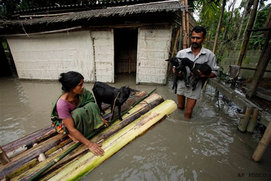
New Delhi, September 23: Nearly 20 people were killed in Sikkim, three in Arunachal Pradesh and more than 7 lakh people affected in Assam after days of incessant rainfall triggered landslides and flash floods in the region on Sunday.
In Assam, 13 districts are said to be affected, the worst-hit being Tinsukhia. The Brahmaputra is flowing above the danger mark and the Kaziranga and Dibru-Saikhowa national parks are under water.
Nearly 60 relief camps have been set up across the state to cater to the flood victims. This is reportedly the fourth time the floods have hit the state this year.
The National Disaster Response Force (NDRF) and the Army have been called in for rescue operations.
In Sikkim, heavy landslides washed away houses, buildings, roads, bridges and everything else in their way in the northern part of the state.
A labour camp at the Teesta Hydel Project site was washed away.
Nearly 20 people are said to have died. These included seven Border Roads Organisation (BRO) personnel, three civilians and one General Reserve Engineer Force (GREF) personnel.
The Indo-Tibetan Border Police (ITBP) claimed that 11 of its personnel were missing.
According to latest reports, nearly 30 km of a highway was washed away and the region between Mangan and Chungthang was said to be affected.
In Arunachal Pradesh, flash floods resulted in the deaths of three people.





Comments
Add new comment